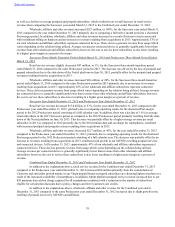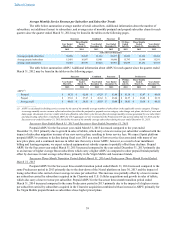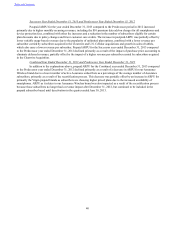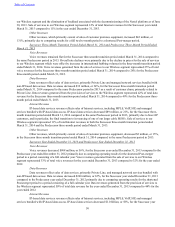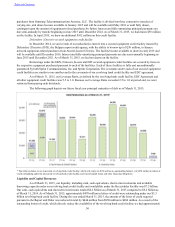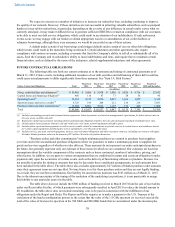Sprint - Nextel 2014 Annual Report Download - page 50
Download and view the complete annual report
Please find page 50 of the 2014 Sprint - Nextel annual report below. You can navigate through the pages in the report by either clicking on the pages listed below, or by using the keyword search tool below to find specific information within the annual report.
Table of Contents
48
reflecting a decrease in customer care costs primarily due to lower call volumes and labor related initiatives, partially offset
by an increase in bad debt expense. Bad debt expense was $155 million for the three-month transition period ended
March 31, 2014, representing a $72 million, or 87%, increase compared to bad debt expense of $83 million for the same
Predecessor period in 2013. The increase in bad debt expense primarily reflects the impact of increased receivables related to
our installment billing program.
Successor Year Ended December 31, 2013 and Predecessor Year Ended December 31, 2012
Sales and marketing expense was $2.6 billion for the Successor year ended December 31, 2013 representing a
decrease of $2.6 billion, or 50%, compared to the Predecessor year ended December 31, 2012 primarily due to comparing
operating results for the shortened Post-merger period to the 2012 Predecessor period consisting of a full calendar year. In
addition, we had a reduction in commissions expense resulting from our decrease in postpaid subscriber gross additions,
which was was partially offset by increased costs resulting from the Clearwire Acquisition and higher media spend.
General and administrative costs were $1.9 billion for the Successor year ended December 31, 2013 representing a
decrease of $2.1 billion, or 53%, compared to the Predecessor year ended December 31, 2012, primarily due to comparing
operating results for the shortened Post-merger period to the 2012 Predecessor period consisting of a full calendar year,
partially offset by additional IT and overhead costs as a result of the Clearwire Acquisition. Bad debt expense was $260
million, a decrease of $281 million in the Successor period 2013 from the Predecessor year ended December 31, 2012. The
decrease is primarily related to comparing a shortened Post-merger period to the 2012 Predecessor period consisting of a full
calendar year.
Combined Year Ended December 31, 2013 and Predecessor Year Ended December 31, 2012
In addition to the increases in the explanations above, the increase in sales and marketing expense for the
Combined year ended December 31, 2013 compared to the Predecessor year ended December 31, 2012 was also due to
increased commissions expense resulting from growth in prepaid sales.
In addition to the explanations above, general and administrative costs decreased for the Combined year ended
December 31, 2013 compared to the Predecessor year ended December 31, 2012 also as a result of lower customer care costs
primarily due to lower call volumes and fewer calls per subscriber. In addition, the decrease in bad debt expense reflects a
decrease in accounts written off, lower average write-off per account, and a decline in involuntary churn.
Segment Earnings - Wireline
We provide a broad suite of wireline voice and data communications services to other communications companies
and targeted business and consumer subscribers. In addition, we provide voice, data and IP communication services to our
Wireless segment. We provide long distance services and operate all-digital global long distance and Tier 1 IP networks. Our
services and products include domestic and international data communications using various protocols such as multiprotocol
label switching technologies (MPLS), IP, managed network services, Voice over Internet Protocol (VoIP), Session Initiated
Protocol (SIP), and traditional voice services. Our IP services can also be combined with wireless services. Such services
include our Sprint Mobile Integration service, which enables a wireless handset to operate as part of a subscriber's wireline
voice network, and our DataLinkSM service, which uses our wireless networks to connect a subscriber location into their
primarily wireline wide-area IP/MPLS data network, making it easy for businesses to adapt their network to changing
business requirements. In addition to providing services to our business customers, the wireline network is carrying
increasing amounts of voice and data traffic for our Wireless segment as a result of growing usage by our wireless
subscribers.
We continue to assess the portfolio of services provided by our Wireline business and are focusing our efforts on
IP-based data services and de-emphasizing stand-alone voice services and non-IP-based data services. We also continue to
provide voice services primarily to business consumers. Our Wireline segment markets and sells its services primarily
through direct sales representatives.
Wireline segment earnings are primarily a function of wireline service revenue, network and interconnection
costs, and other Wireline segment operating expenses. Network costs primarily represent special access costs and
interconnection costs, which generally consist of domestic and international per-minute usage fees paid to other carriers. The
remaining costs associated with operating the Wireline segment include the costs to operate our customer care and billing
organizations in addition to administrative support. Wireline service revenue and variable network and interconnection costs
fluctuate with the changes in our customer base and their related usage, but some cost elements do not fluctuate in the short
term with the changes in our customer usage. Our wireline services provided to our Wireless segment are generally accounted
for based on market rates, which we believe approximate fair value. The Company generally re-establishes these rates at the


